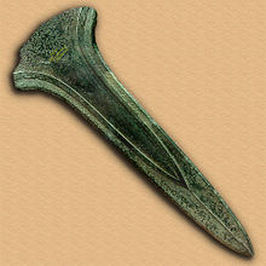
The Bronze age started around 3000bc, nobody is really sure how it happened or who invented the method. Bronze is an alloy of two metals Copper and Tin. So who ever thought of this was a pretty clever person. The melting of Copper was probably found out when someone threw copper laden rocks onto a fire. If you know a little chemistry you will know that this will turn the flames of the fire green. In an age of mystics and believed magic this would have been an impressive sight rather like a firework today. The addition of Tin however remains a mystery. What we do know about tin is it's not widely available, in actual fact its quite a rare metal. One of the sources of this metal was Cornwall in the south west corner of the United Kingdom. Trade of this metal was rife with other sources on the other side of the English Channel in France. The earliest bronze objects had tin or arsenic content of less than 2% and are therefore believed to be the result of unintentional alloying due to trace metal content in the copper ore. Tin was first mined in Europe around 2500 BC knowledge of tin bronze and tin extraction techniques spread to Brittany and Cornwall around 2000 BC and from north-western Europe to north-western Spain and Portugal around the same time.
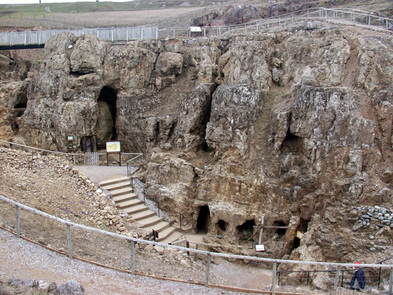
This is Great Orme copper mine in Llandudno, Wales. This is the Oldest mining structure in the world. Each of those hole you can see has been mined by human hand using stone tools (Bronze tools would have been far to valuable and fragile to use on such a surface) and deer or reindeer antlers shaped into picks. Some of the holes are so tiny they can only have been worked by children some maybe as young as five years old. The workings go deep into the rock surface where they would have worked in pitch darkness in cramped spaces with high levels of humidity, many phobias in one place for many. The ore would have been processed by women and men to old to mine, pounded with large rocks to extract the valuable copper. This metal would then have been smelted to form copper ingots around the size of a golf ball. Trade from Llandudno would have been fairly easy on the coast where tin could have been imported and copper exported.
In Great Britain, the Bronze Age is considered to have been the period from around 2100 to 750 BC. Migration brought new people to the islands from the continent. Recent tooth enamel isotope research on bodies found in early Bronze Age graves around Stonehenge indicate that at least some of the migrants came from the area of modern Switzerland. The Beaker culture displayed different behaviours from the earlier Neolithic people, and cultural change was significant. Integration is thought to have been peaceful, as many of the early henge sites were seemingly adopted by the newcomers. What is the Beaker culture well they were people who used a specific type of pot found all over western Europe. Simply its a cup that looks a lot like a modern day beaker or cups without the handles.
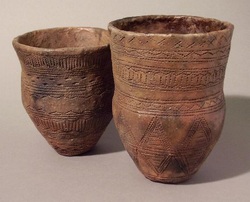
A pair of Bronze age beakers
These Beakers were used for everything from drinking to storing the cremated remains of ancestors and they come out of the earth everywhere. Archaeologists believe that they are modelled on the crucibles that metal workers would have smelted the metal in so to many people they were a source of magic and held many properties of the gods.
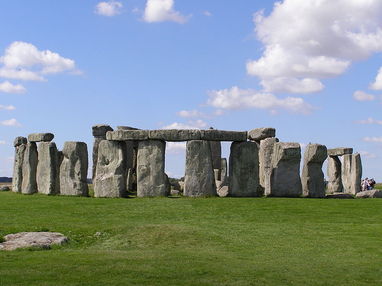
Around this time a man known as the Amesbury archer was buried he is a classic beaker person and during this time when burial was getting more individual this man was given a full ceremonial burial. His grave had the greatest number of artefacts ever found in a British Bronze Age burial. Among those discovered were: Five funerary pots of the type associated with the "Beaker culture"; three tiny copper knives, more for show than for violent use; 16 barbed flint arrowheads; a kit of flint-knapping and metalworking tools, including cushion stones that functioned as a kind of portable anvil and that suggests he was a smithy; and some boar's tusks. On his forearm was a black Stone wrist-guard. A similar red wrist-guard was by his knees. With the second wrist-guard was a shale belt ring and a pair of gold hair ornaments. It has been suggested that he was a part of Stonehenge's construction or a very important member of the society there. Opposite is a picture of Stonehenge in Wiltshire. It was probably built first around 4000bc but the Stonehenge you see today in the picture was built around 2600bc The big stones you see on the outside are local stones to the area and came from the Marlborough downs about 15-20 miles away still some task to drag there. they were hauled upright by brute force. you build a dirt slope and you use a wooden A frame so called because it looks like an 'A' you put rope over the top of the A and haul. The top stones were a little different they used wood to hoist them up. Place one hand on the other at 90 degree angles, then remove the hand and place it on top. This is how they raised the stone. You lift it at one side, slide wood under it lift it on the other side slide wood under it and so on until its level with the top of the standing stones then you shuffle it over with big tree trunk sized levers and it fits into two stone sockets on top of the stones. The really amazing bit is the stones INSIDE Stonehenge. These smaller stones are blue-stones they have a glittery blue shine to them. They come from a place in Wales over 200 miles away. which means they had sophisticated trading methods and also good transport networks. The stones were probably shipped by boat rather than dragged overland as Stonehenge is quite close to a major British river, the River Avon. (Curiously Avon means River, so its real name is River river, which is pretty unimaginative, until you realise there are 6 rivers called the River Avon in England)
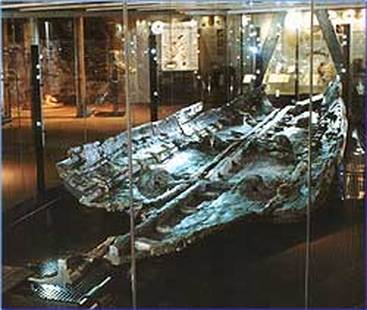
Here is a picture of a Bronze age boat, in fact one of the few bronze age boats ever found in the world. Its structure however would not be unfamiliar to a modern boat builder. The boat was made up of at least six oak timbers lashed together with yew wood, with all the joints reinforced with a thin lath of oak, covering moss pushed into the joint. The two central planks are joined by the use of wedges pushed through a central rail and a series of cleats hammered together. Sails would have been made using hazel weave rather like a basket weave only on a flat surface this would have allowed the boat to travel vast distances all over Europe.
The Bronze Age people lived in round houses and divided up the landscape. Stone rows are to be seen on, for example, Dartmoor. They ate cattle, sheep, pigs and deer as well as shellfish and birds. They carried out salt manufacture. The wetlands were a source of wildfowl and reeds. There was ritual deposition of offerings in the wetlands and in holes in the ground. They were a sophisticated people just think when would you have ever thought of heating rocks up to make metal....
The end of the bronze age was caused by a number of things. Chiefly amongst those was climate change. The weather got colder and wetter. People were no longer using bronze as a currency anymore and much like to day a financial and economical crisis took place. Hordes of bronze age axes were piled into the ground by people who must have been hoping that once the famine and hard times passed they would return to life as they had always known it. This wasn't to be. Along with a horde that was dug up in Isleham near Ely in the English county of Cambridgeshire, there was one mysterious object that wasn't Bronze.....It was Iron.....
The Bronze Age people lived in round houses and divided up the landscape. Stone rows are to be seen on, for example, Dartmoor. They ate cattle, sheep, pigs and deer as well as shellfish and birds. They carried out salt manufacture. The wetlands were a source of wildfowl and reeds. There was ritual deposition of offerings in the wetlands and in holes in the ground. They were a sophisticated people just think when would you have ever thought of heating rocks up to make metal....
The end of the bronze age was caused by a number of things. Chiefly amongst those was climate change. The weather got colder and wetter. People were no longer using bronze as a currency anymore and much like to day a financial and economical crisis took place. Hordes of bronze age axes were piled into the ground by people who must have been hoping that once the famine and hard times passed they would return to life as they had always known it. This wasn't to be. Along with a horde that was dug up in Isleham near Ely in the English county of Cambridgeshire, there was one mysterious object that wasn't Bronze.....It was Iron.....
 RSS Feed
RSS Feed